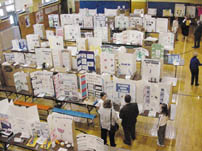The annual Roosevelt School Science Fair was coming, and all of the school’s fifth and sixth graders had to think of topics for interesting presentations. Their creative minds were definitely hard at work. Stephanie Orru constantly kept hearing her mother complain about the rusted gate in front of her house. Bingo. The sixth grader decided to concentrate her project on how rust is formed on nails. Smart and practical thinking. “In order to protect the metal, it has to be coated with zinc,” Orru said. “I knew I couldn’t fix the fence, so that’s why I chose the topic.” Katie Gross, another sixth grader, was frustrated by the long winter, making like Peggy Fleming with all the ice and snow as she dashed to school every day. “I was sick and tired of slipping on the ice all over the place,” Gross said. So she decided to find out what substance would melt the ice best, choosing between limestone, rock salt – and surprise, surprise – kitty litter. “A lot of people use kitty litter and they keep it in their cars if they get stuck in the snow and ice,” Gross explained. “Basically, they use more of a mix.” Gross also showed which substances were the best for protecting the pavement and which were the worst. “I’m not slipping anymore,” Gross laughed. Joseph Poole, also in the sixth grade, listened to his father talk about being on the Atkins Diet and cutting down on the intake of sugar. So Poole decided to try to find out what foods had the highest and lowest concentrations of sugar, foods like ketchup, bananas, cereal and even soda. “Incredibly, Surge (a popular soft drink) had less sugar concentration than bananas,” Poole said. Fellow sixth grader Francis Petrie decided to find out what foods produce the most amount of gas. It’s not necessary to report where Petrie got the inspiration for his project. “When I told people that I was going my project on what foods produce the most gas, they all laughed,” Petrie said. “It just came to mind one day. A lot of people like to know why I did. A lot of people are faced with the problem of having too much gas.” Don’t we all know that one? However, Petrie didn’t want to say whether it was any one of his family members. For his experiment, Petrie took canned, frozen and fresh vegetables, put the substances in beakers and allowed three days for the natural gases to rise to the top of the beakers. And the conclusion? “Frozen vegetables produce the most,” Petrie said. Definitely useful information. More than 100 All told, some 163 students made scientific presentations that were judged by a panel of teachers on Thursday. The students then presented them to parents and friends Thursday night and awards were presented on Friday morning. The presentations turned Roosevelt School’s tiny gymnasium into a scientific wonderland. “It really is wonderful,” said Eileen Hochman, one of the Science Fair moderators and a sixth grade teacher at the school. “They all put a lot of time and effort into their projects and they learned about [not just] the scientific method, but things that they can use in all walks of life. They really enjoy doing it.” Although the students do receive a grade for their presentations, they are not required to enter the science fair. But most do anyway, just for the fun and the competition. And the students certainly have a lot of pride in their efforts. Take sixth grader Oscar Lee. His project was definitely high-tech biology. He looked at whether or not acid rain would have an effect on spirogyra, which is a form of green algae (and for Baby Boomers: not the calypso jazz band of the ’80s). So Lee took spirogyra cultures, combined them with rainwater, and found that it definitely destroyed the growth. “Which means that it would have a serious effect on the food chain,” Lee said. “It would affect plant life, which would destroy vegetables, which would then hurt livestock and fish that we eat as well.” Amazing. Yes, the youngster is a sixth grader. You tend to forget when they’re steeping themselves in scientific theory. Fifth grader Stephanie Azcona was also ingenious. She studied moon features and how craters on the moon were created. “Craters were formed by other large objects hitting the lunar surface,” Azcona explained. “So I took some sand and took rocks and threw the rocks into the sand to recreate what happened on the moon.” Fifth grade teacher Dolores Messina was happy with the presentations her students made. They weren’t as extensive or expansive as the sixth graders’, but impressive all the same. “This is where the seed is planted,” Messina said. “We’re certainly getting a chance to reap the benefits of their hard work. I think this inspires the fifth graders to do something bigger and greater next year. But a lot of my students really surprised me with their projects.” Not only did the Science Fair promote learning, but the children also had fun. “It really was fun to do,” Gross said. “I didn’t think it would be, at first, but it really was.” “I learned a lot of things, but this definitely makes me want to learn more about the moon,” Azcona said. And that’s the true reason for doing a science fair project.
Our Digital Archive from 2000 – 2016
